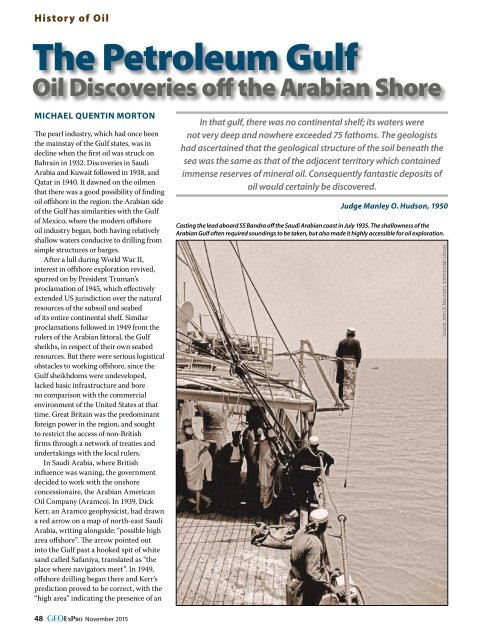Iraqi Kurdistan All in the Timing
GEO_ExPro_v12i6
GEO_ExPro_v12i6
You also want an ePaper? Increase the reach of your titles
YUMPU automatically turns print PDFs into web optimized ePapers that Google loves.
History of Oil<br />
The Petroleum Gulf<br />
Oil Discoveries off <strong>the</strong> Arabian Shore<br />
MICHAEL QUENTIN MORTON<br />
The pearl <strong>in</strong>dustry, which had once been<br />
<strong>the</strong> ma<strong>in</strong>stay of <strong>the</strong> Gulf states, was <strong>in</strong><br />
decl<strong>in</strong>e when <strong>the</strong> first oil was struck on<br />
Bahra<strong>in</strong> <strong>in</strong> 1932. Discoveries <strong>in</strong> Saudi<br />
Arabia and Kuwait followed <strong>in</strong> 1938, and<br />
Qatar <strong>in</strong> 1940. It dawned on <strong>the</strong> oilmen<br />
that <strong>the</strong>re was a good possibility of f<strong>in</strong>d<strong>in</strong>g<br />
oil offshore <strong>in</strong> <strong>the</strong> region: <strong>the</strong> Arabian side<br />
of <strong>the</strong> Gulf has similarities with <strong>the</strong> Gulf<br />
of Mexico, where <strong>the</strong> modern offshore<br />
oil <strong>in</strong>dustry began, both hav<strong>in</strong>g relatively<br />
shallow waters conducive to drill<strong>in</strong>g from<br />
simple structures or barges.<br />
After a lull dur<strong>in</strong>g World War II,<br />
<strong>in</strong>terest <strong>in</strong> offshore exploration revived,<br />
spurred on by President Truman’s<br />
proclamation of 1945, which effectively<br />
extended US jurisdiction over <strong>the</strong> natural<br />
resources of <strong>the</strong> subsoil and seabed<br />
of its entire cont<strong>in</strong>ental shelf. Similar<br />
proclamations followed <strong>in</strong> 1949 from <strong>the</strong><br />
rulers of <strong>the</strong> Arabian littoral, <strong>the</strong> Gulf<br />
sheikhs, <strong>in</strong> respect of <strong>the</strong>ir own seabed<br />
resources. But <strong>the</strong>re were serious logistical<br />
obstacles to work<strong>in</strong>g offshore, s<strong>in</strong>ce <strong>the</strong><br />
Gulf sheikhdoms were undeveloped,<br />
lacked basic <strong>in</strong>frastructure and bore<br />
no comparison with <strong>the</strong> commercial<br />
environment of <strong>the</strong> United States at that<br />
time. Great Brita<strong>in</strong> was <strong>the</strong> predom<strong>in</strong>ant<br />
foreign power <strong>in</strong> <strong>the</strong> region, and sought<br />
to restrict <strong>the</strong> access of non-British<br />
firms through a network of treaties and<br />
undertak<strong>in</strong>gs with <strong>the</strong> local rulers.<br />
In Saudi Arabia, where British<br />
<strong>in</strong>fluence was wan<strong>in</strong>g, <strong>the</strong> government<br />
decided to work with <strong>the</strong> onshore<br />
concessionaire, <strong>the</strong> Arabian American<br />
Oil Company (Aramco). In 1939, Dick<br />
Kerr, an Aramco geophysicist, had drawn<br />
a red arrow on a map of north-east Saudi<br />
Arabia, writ<strong>in</strong>g alongside: “possible high<br />
area offshore”. The arrow po<strong>in</strong>ted out<br />
<strong>in</strong>to <strong>the</strong> Gulf past a hooked spit of white<br />
sand called Safaniya, translated as “<strong>the</strong><br />
place where navigators meet”. In 1949,<br />
offshore drill<strong>in</strong>g began <strong>the</strong>re and Kerr’s<br />
prediction proved to be correct, with <strong>the</strong><br />
“high area” <strong>in</strong>dicat<strong>in</strong>g <strong>the</strong> presence of an<br />
In that gulf, <strong>the</strong>re was no cont<strong>in</strong>ental shelf; its waters were<br />
not very deep and nowhere exceeded 75 fathoms. The geologists<br />
had ascerta<strong>in</strong>ed that <strong>the</strong> geological structure of <strong>the</strong> soil beneath <strong>the</strong><br />
sea was <strong>the</strong> same as that of <strong>the</strong> adjacent territory which conta<strong>in</strong>ed<br />
immense reserves of m<strong>in</strong>eral oil. Consequently fantastic deposits of<br />
oil would certa<strong>in</strong>ly be discovered.<br />
Judge Manley O. Hudson, 1950<br />
Cast<strong>in</strong>g <strong>the</strong> lead aboard SS Bandra off <strong>the</strong> Saudi Arabian coast <strong>in</strong> July 1935. The shallowness of <strong>the</strong><br />
Arabian Gulf often required sound<strong>in</strong>gs to be taken, but also made it highly accessible for oil exploration.<br />
Source: John D. Mounta<strong>in</strong>, Smithsonian Library<br />
48 GEOExPro November 2015


